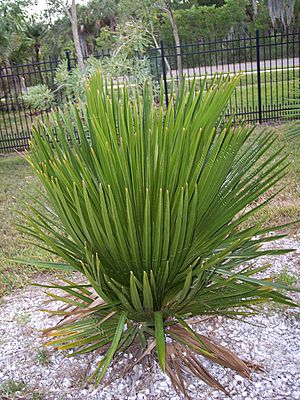Copernicia macroglossa facts for kids
Quick facts for kids Copernicia macroglossa |
|
|---|---|
 |
|
| Scientific classification | |
| Genus: |
Copernicia
|
| Species: |
macroglossa
|
The Copernicia macroglossa is a type of palm tree. It is found only in western and central Cuba. This means it is endemic to that area.
Contents
Where Does This Palm Grow?
The Copernicia macroglossa palm loves to grow in Cuba. It especially likes a special kind of soil called serpentine soil. You can find it in many Cuban areas, like La Habana, Las Villas, and Pinar del Río.
Even though it's from Cuba, people have also grown this tree in parts of Central America and some Caribbean islands.
What Does the Petticoat Palm Look Like?
The Copernicia macroglossa has a few nicknames. People call it the Petticoat palm, Jata palm, or Jata de Guanabacoa. Its scientific name comes from the famous astronomer, Copernicus. He was the one who figured out that the sun is the center of our solar system! This palm is also a "center of attention" for many gardeners because of its amazing look.
This palm can grow in soils that might not seem very rich. But these soils still have the right nutrients for it. In nature, it grows in the unique serpentine soils of Cuba.
The Petticoat palm is very good at handling dry weather. It grows best in full sunlight, with lots of heat and humidity. It has a single trunk that can grow up to 8 inches wide. It can also reach over 30 feet tall!
Its leaves are shaped like upright fans. They grow in a spiral pattern at the top of the trunk. A cool "beard" of dry, fan-shaped leaves hangs down from the upper stem. This beard covers about half of the trunk. This is the famous "petticoat" that makes the palm so special! We don't know why the palm has this petticoat.
The Copernicia macroglossa is a monoecious palm. This means it has both male and female parts on the same plant. Its flowers are white. After the flowers, it grows black fruits that are about 1 inch long and usually oval.
How Does This Palm Help Nature?
In late summer, the small fruits turn a dark black color. This attracts many birds and bats. These animals help spread the palm's seeds by eating the fruits and carrying them away.
Scientists have seen bats and birds visiting the "petticoat" part of the palm. They do this even before the fruits are ripe. The reason for this is still a mystery! This palm gets pollinated by other plants. Insects and wind help carry pollen between the palms.
Why Do People Grow This Palm?
Many gardeners love this plant because of its unique "petticoat." It makes the palm look very beautiful. Also, its bright leaves and the spaces between them reflect light. This adds even more to its beauty.
You can grow this palm in open tropical or subtropical areas. It needs soil that drains well and lots of sunlight.
If you live in a subtropical area that gets frost, this palm might get damaged. It doesn't like cold weather very much. Also, it grows quite slowly. This can be a challenge for gardeners.
Because it looks so good and grows slowly, a fully grown palm is worth a lot of money. A healthy palm that is 20 to 30 feet tall can cost around $200 to $300.
See also
 In Spanish: Palmera de abrigo para niños
In Spanish: Palmera de abrigo para niños

